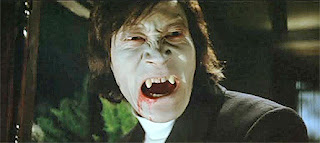 Genre fans will be
celebrating on May 15 when Arrow Video, with domestic sales and distribution
support provided by MVD Entertainment Group, releases the double-disc Blu-ray
collection of The Bloodthirsty Trilogy.
Genre fans will be
celebrating on May 15 when Arrow Video, with domestic sales and distribution
support provided by MVD Entertainment Group, releases the double-disc Blu-ray
collection of The Bloodthirsty Trilogy.
Recognizing the success
that Hammer Films and Amicus Films were having with their horror and anthology
releases, Japanese filmmaker Michio Yamamoto teamed with Toho Studios in the
early 70s for a trio of gothic-like horror films featuring vampires. Arrow Video has new hi-def transfer ready
(from the original film elements of all three films in the series — The
Vampire Doll, Lake of Dracula, and Evil of Dracula — in this Blu-ray
collection.
The first of these was The
Vampire Doll, which opened theatrically in Japan during the summer of
1970, but did not find its way to the domestic marketplace until the following
summer (August of 1971). Theatrical
distribution at that time is a little murky … Toho maintained distribution
offices in both Los Angeles and New York at the time, but it appears that The
Vampire Doll was strictly an arthouse release, in Japanese with English
subtitles.
Lake of Dracula was released in June of 1971 in Japan, but did
not arrive on these shores until around Labor Day of 1973. It too appears to have been a Japanese
import destined for limited arthouse exposure.
Lastly, Evil
of Dracula didn’t get a theatrical release in Japan until the summer of
1974 and it was another nine months (April of 1975) before it arrived in the
United States as a Toho release — again, in Japanese with English subtitles.
In the early 1980s Lake
of Dracula and Evil of Dracula were dubbed into
English and released through UPA as edited television movies … eventually on
VHS as well (Paramount released Evil of Dracula on VHS, of that much
we are certain).
So for the most part, the
three films that make up Michio Yamamoto’s The Bloodthirsty Trilogy will be new
to American home entertainment audiences.
Gothic horror and Japanese horror … a clash of styles, but somehow it
all works out.
A newly prepared video
session with film critic and author Kim Newman (“Nightmare Movies: A Critical History
of the Horror Film, 1968–88) is included in the collection.



No comments:
Post a Comment